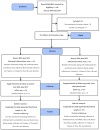Long-Term Impact of Multiple Micronutrient Supplementation on Micronutrient Status, Hemoglobin Level, and Growth in Children 24 to 59 Months of Age: A Non-Randomized Community-Based Trial from Pakistan
- PMID: 37049531
- PMCID: PMC10096793
- DOI: 10.3390/nu15071690
Long-Term Impact of Multiple Micronutrient Supplementation on Micronutrient Status, Hemoglobin Level, and Growth in Children 24 to 59 Months of Age: A Non-Randomized Community-Based Trial from Pakistan
Abstract
Cost-effective interventions are needed to address undernutrition, particularly micronutrient deficiencies, which are common in children under the age of five in low- and middle-income countries. A community-based, non-randomized clinical trial was undertaken in the Kurram district of Khyber Pakhtunkhwa from January 2018 to June 2019, to evaluate the effect of locally produced micronutrient powder (local name: Vita-Mixe) on plasma micronutrient status, hemoglobin level, and anthropometric outcomes. Children aged 24-48 months old were recruited and allocated to the intervention and control arm of the study. The enrolled children in the intervention arm received one micronutrient powder (MNP) sachet for consumption on alternate days for 12 months. To assess the impact of the intervention on plasma levels of zinc, vitamin D, vitamin A, and hemoglobin level, blood samples were taken at baseline and after one year following the intervention. The analysis was conducted using Enzyme-Linked Immunosorbent Assay (ELISA), atomic absorption spectrometry, and an automated hematology analyzer. For the impact on growth parameters, the anthropometric assessment was performed using WHO standard guidelines. A 24 h dietary recall interview was used to assess the nutrient intake adequacy. Results showed that in the intervention arm, children had on average a 7.52 ng/mL (95% CI 5.11-9.92, p-value < 0.001) increase in the plasma level of vitamin A, 4.80 ng/mL (95% CI 1.63-7.95, p-value < 0.002) increase in vitamin D levels and 33.85 µg/dL (95% CI 24.40-43.30, p-value < 0.001) increase in the plasma zinc level, as well as a 2.0g/dL (95% CI 1.64-2.40, p-value < 0.001) increase in hemoglobin level. Statistically significant improvement was observed in the weight-for-height z-score (WHZ) (from -1.0 ± 0.88 to -0.40 ± 1.01, p < 0.001) and weight-for-age z-score (WAZ) (from -1.40 ± 0.50 to -1.05 ± 0.49, p < 0.001) in the intervention group compared to the control group. No statistically significant change was observed in the height-for-age z-score (HAZ) in the intervention group (p = 0.93). In conclusion, micronutrient powder supplementation is a cost-effective intervention to improve the micronutrient status, hemoglobin level, and growth parameters in under-five children, which can be scaled up in the existing health system to address the alarming rates of undernutrition in Pakistan and other developing countries.
Keywords: MNP; anemia; growth parameter; malnutrition; stunting; vitamin A; vitamin D; zinc.
Conflict of interest statement
The authors declare no conflict of interest.
Similar articles
-
Effectiveness of locally produced ready to use supplementary food on hemoglobin, anthropometrics, and plasma micronutrients concentrations of 6 to 23 months age children: a non-randomized community-based trial from Pakistan.Front Nutr. 2023 Jul 27;10:1176778. doi: 10.3389/fnut.2023.1176778. eCollection 2023. Front Nutr. 2023. PMID: 37575332 Free PMC article.
-
Home fortification of foods with multiple micronutrient powders for health and nutrition in children under two years of age (Review).Evid Based Child Health. 2013 Jan;8(1):112-201. doi: 10.1002/ebch.1895. Evid Based Child Health. 2013. PMID: 23878126 Review.
-
Home fortification of foods with multiple micronutrient powders for health and nutrition in children under two years of age.Cochrane Database Syst Rev. 2020 Feb 28;2(2):CD008959. doi: 10.1002/14651858.CD008959.pub3. Cochrane Database Syst Rev. 2020. PMID: 32107773 Free PMC article.
-
Effect of provision of daily zinc and iron with several micronutrients on growth and morbidity among young children in Pakistan: a cluster-randomised trial.Lancet. 2013 Jul 6;382(9886):29-40. doi: 10.1016/S0140-6736(13)60437-7. Epub 2013 Apr 18. Lancet. 2013. PMID: 23602230 Clinical Trial.
-
A mixed methods study to assess the effectiveness of food-based interventions to prevent stunting among children under-five years in Districts Thatta and Sujawal, Sindh Province, Pakistan: study protocol.BMC Public Health. 2017 Jan 5;17(1):24. doi: 10.1186/s12889-016-3976-y. BMC Public Health. 2017. PMID: 28056945 Free PMC article. Clinical Trial.
Cited by
-
Effectiveness of locally produced ready-to-use supplementary foods on the prevention of stunting in children aged 6-23 months: a community-based trial from Pakistan.Br J Nutr. 2024 Apr 14;131(7):1189-1195. doi: 10.1017/S0007114523002702. Epub 2023 Nov 28. Br J Nutr. 2024. PMID: 38012887 Free PMC article. Clinical Trial.
-
Relationship between composite dietary antioxidants index and growth indicators in children aged 3-12 years: results from two observational studies.Front Nutr. 2025 Mar 20;12:1551754. doi: 10.3389/fnut.2025.1551754. eCollection 2025. Front Nutr. 2025. PMID: 40181947 Free PMC article.
References
-
- Stevens G.A., Beal T., Mbuya M.N.N., Luo H., Neufeld L.M., Addo O.Y., Adu-Afarwuah S., Alayón S., Bhutta Z., Brown K.H., et al. Micronutrient deficiencies among preschool-aged children and women of reproductive age worldwide: A pooled analysis of individual-level data from population-representative surveys. Lancet Glob. Health. 2022;10:e1590–e1599. doi: 10.1016/S2214-109X(22)00367-9. - DOI - PMC - PubMed
-
- Pakistan, UNICEF . National Nutritional Survery 2018: Key Finding Reports. Nurtition wing MoNHSRacGoP; Islamabad, Pakistan: 2018.
Publication types
MeSH terms
Substances
LinkOut - more resources
Full Text Sources
Medical


